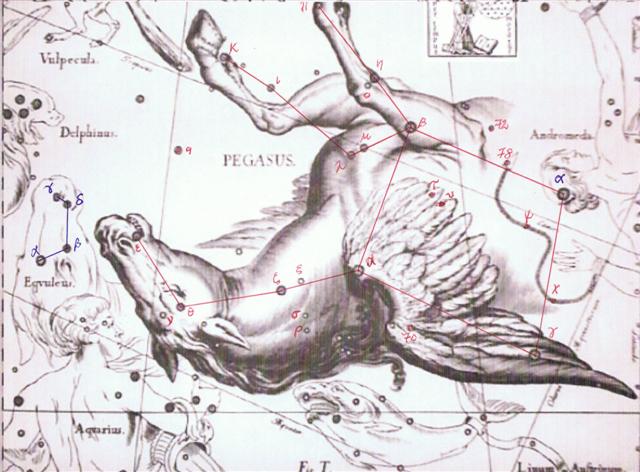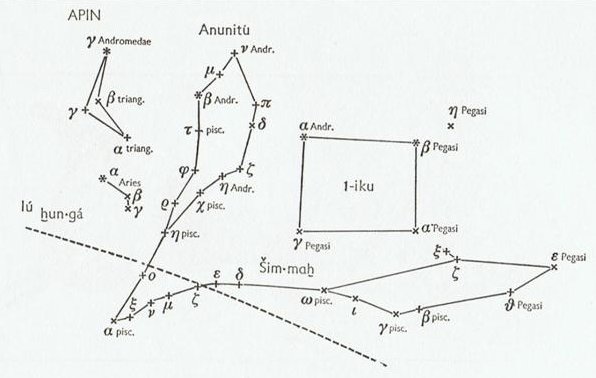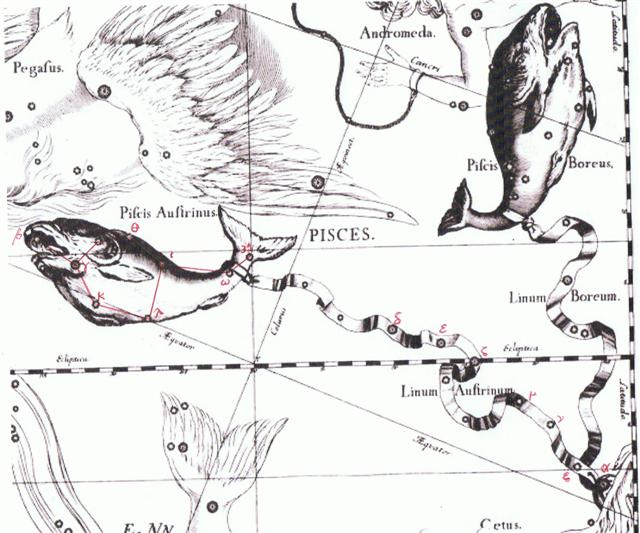Flimsy
though as
these
arguments
may seem
this was
probably the
method to
read
rongorongo
texts.
Uncertainty
could not be
cancelled by
simple
logic.
Instead it
was necessary
to
accumulate
perceptions
into
collages and to count.
With
redundance a proper
reading was
possible.
Instead of
excluding
('either-or',
oppositon)
the method
was
inclusive
('both-and',
complementarity).
It was not a
closed
system but
an open
system.
 |
 |
 |
| Gb7-5 |
Gb7-6 (416) |
Gb7-7 (188) |
| JANUARY 23 |
24 |
25 (390) |
| Andromeda Galaxy, π Andromedae (7.7) |
ε Andromedae (8.2), Delta (8.4), Schedir (8.6), ζ Andromedae, μ Phoenicis (8.9) |
ξ Phoenicis (9.0), ρ Tucanae (9.1), Deneb Kaitos, η Phoenicis (9.4), Al Nithām (9.6) |
| March 28 |
29 (88) |
30 (454) |
| 'March 1 (60) |
2 |
3 |
| NAKSHATRA DATES: |
| JULY 25 |
26 |
27 (208) |
| α Muscae (190.2), τ Centauri (190.5), χ Virginis (190.7) Alderamin
|
Al ┴wwā'-11 / Shur-mahrū-shirū-19 |
ι Crucis (192.2), β Muscae (192.5), Mimosa (192.9) |
| Sombrero Galaxy (191.1), ρ Virginis (191.4), PORRIMA, γ Centauri (191.5) |
| September 27 |
28 |
29 (272) |
| 'August 31 |
'September 1 |
2 (245) |
Possibly the
'Man-Bird' (tagata
manu) in
Gb7-7
illustrates
the
transformation
from 'Man'
(down on
earth)
into
'Climbing Bird'
(up in the
sky),
an idea
which not
only could
be reflected
in the
yearly race
for the
first
manu tara
egg but also
in the flight
from
the 'land of
the
nocturnal
eye' (henua mata po uri)
to the 'land of the light and clear eye' (henua mata maeha)
in the myth
just
mentioned.
However,
tagata
manu was
not a real
bird (manu
rere), only its
resemblance
(manu),
a figure
without
the
inner life.

In Gb7-7
the
unusual
form
created
under
the
front
wing of
the bird
(with
mouth
closed
and
front
foot
drawn
down)
reminded
me of
the
complementary
form
exhibited
in front
of the
toko
at
Terminalia
(which
may have
been
followed
by a
Bissextum
tokorua
every
4th
year):
 |
 |
 |
 |
| Gb6-25 |
Gb6-26 (408) |
Gb6-27 (*1) |
Gb6-28 (181) |
| JANUARY 15 |
16 (*301 = *408 - *107) |
17 |
18 (383) |
| θ Oct. (364.9) |
Al Fargh al Thāni-25 |
Uttara Bhādrapadā-27 / Wall-14 |
χ Pegasi (2.1), θ Andromedae (2.7) |
| Caph, SIRRAH (0.5), ε Phoenicis, γ│ Oct. (0.8) |
ο Oct. (1.3), ALGENIB PEGASI (1.8) |
| March 20 |
Equinox (80) |
22 |
23 |
| 'February 21 |
22 (53) |
Terminalia |
24 (*340) |
Possibly
it
meant
light
had
not
yet
arrived,
although
the
hole
for
its arrival
(pu)
was
there
waiting.
The
form
under
the
prolonged
wing has
nothing
inside
and
it
could
be a
Sign
for
the
winter
half
of
the
year.
The
Bird
Man
could
have
alluded
to
the
feathered
Pegasus
Square,
with
the
head
of
Andromeda
in
its
4th
corner
(at
Rogo
in
the
G
text):

...
The
Raven
stole
the
skin
and
form
of
the
newborn
child.
Then
he
began
to
cry
for
solid
food,
but
he
was
offered
only
mother's
milk.
That
night,
he
passed
through
the
town
stealing
an
eye
from
each
inhabitant.
Back
in
his
foster
parents'
house,
he
roasted
the
eyes
in
the
coals
and
ate
them,
laughing.
Then
he
returned
to
his
cradle,
full
and
warm.
He
had
not
seen
the
old
woman
watching
him
from
the
corner
-
the
one
who
never
slept
and
who
never
moved
because
she
was
stone
from
the
waist
down
...
In
the
picture
below
there
is
nothing
to
the
right
of
the
winter
solstice
beam
but
plenty
to
the
left
of
the
summer
solstice
beam.
Since
the
time
of
Mnjadra
the
relevant
stars
would
have
gone
at
least a
quarter
of a
year
ahead:

Evidence
accumulates
slowly,
like
droplets
emerging
in a
spring.
From η Andromedae
(at
the rising
Northern
Fish)
to
Anunitum
(ε
Pisces)
there
were
5
days:

 |
 |
 |
 |
| Gb7-8 |
Gb7-9 |
Gb7-10 (420) |
Gb7-11 (192) |
| JANUARY 26 |
27 (392) |
28 |
29 |
| Achird (10.7) |
Legs-15 |
Cih, λ Tucanae (12.4), φ│ Ceti (12.6), μ Andromedae (12.8) |
φ4 Ceti (13.2) |
| ν Andromedae (11.0), φ▓ Ceti (11.1), ρ Phoenicis (11.2), η ANDROMEDAE (11.4) |
| March 31 (90) |
April 1 (19 * 24) |
2 (457) |
3 |
| 'March 4 |
5 (64) |
6 (*350) |
7 |
| NAKSHATRA DATES: |
| JULY 28 |
29 (210) |
30 |
31 |
| no star listed (193) |
κ Crucis (194.4), ψ Virginis (194.5), μ Crucis, λ Crucis (194.6), Alioth, ι Oct. (194.8) |
Minelauva (195.1), Cor Caroli (195.3) |
δ Muscae (196.5), Vindemiatrix (196.8) |
| September 30 (273) |
October 1 |
2 |
3 |
| 'September 3 |
4 |
5 (*168) |
6 (249) |
 |
 |
 |
 |
 |
 |
| Gb7-12 (193) |
Gb7-13 |
Gb7-14 |
Gb7-15 |
Gb7-16 |
Gb7-17 (427) |
| JANUARY 30 |
31 |
FEBRUARY 1 |
2 (33) |
3 |
4 (400) |
| no star listed (14) |
1h (15.2) |
Al Batn Al Hūt-26 / Revati-28 / 1-iku-1 |
ν Phoenicis (17.4), κ Tucanae (17.6) |
no star listed (18) |
Adhil (19.3) |
| β Phoenicis (15.1), υ Phoenicis, ι Tucanae (15.6), ζ Phoenicis (15.7) |
MIRACH, Keun Nan Mun (16.0), ANUNITUM (16.5), REVATI (16.9) Regulus
|
| April 4 |
5 (460) |
6 |
7 |
8 |
9 (99) |
| 'March 8 |
9 |
10 |
11 (*355) |
12 |
13 (72) |
| NAKSHATRA DATES: |
| AUGUST 1 |
2 |
3 (*135) |
4 (216) |
5 |
6 |
| 13h (197.8) |
Apami-Atsa, ψ Hydrae (198.5) |
Al Dafīrah (199.4) |
σ Virginis (200.4) |
γ Hydrae (201.0), ι Centauri (201.4) |
Al Simāk-12 / Chitra-14 / Horn-1 / Sa-Sha-Shirū-20 |
| ξ╣ Centauri (197.1), ξ▓ Centauri (197.9) |
Mizar (202.4), SPICA, Alcor (202.7) Sadalmelik
|
| October 4 |
5 |
6 |
7 (280) |
8 |
9 |
| 'September 7 (250) |
8 |
9 |
10 (*173) |
11 |
12 |
A lean mago in front ought to mean a lean season was ahead. Or possibly that pregnancy was over. 
The Hindu system had Revati as its last station:
| AQUARIUS: |
| 25 |
Shatabisha |
γ Aquarii |
Empty circle, 1000 flowers or stars |
338 = 314 + 24 |
| comprising a hundred physicians |
Sadachbia |
Feb 22 (418) |
| PEGASUS: |
| 26 |
Purva Bhādrapadā |
α (Markab) and β Pegasi (Scheat) |
Swords or two front legs of funeral cot, man with two faces |
349 = 338 + 11 |
| the first of the blessed feet |
Markab |
March 5 (429) |
| 27 |
Uttara Bhādrapadā |
γ Pegasi (Algenib) and α Andromedae (Sirrah) |
Twins, back legs of funeral cot, snake in the water |
366 = 349 + 17 |
| the second of the blessed feet |
Algenib |
March 22 (446) |
| PISCES: |
| 28 |
Revati |
ζ Piscium |
Fish or a pair of fish, drum |
381 = 366 + 15 |
| prosperous |
Revati |
Apr 6 (461) |
|










